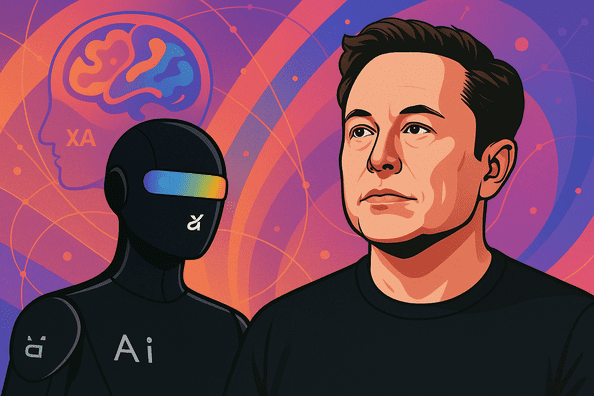In recent years, the world of artificial intelligence has witnessed a significant surge in the development of advanced language models. Among these, Grok AI and ChatGPT have emerged as two of the most prominent contenders, each boasting unique features and capabilities. As we delve into the comparison of Grok AI vs ChatGPT, it’s essential to understand the context in which these models operate and the specific strengths they bring to the table.
Grok AI, developed by xAI, has gained attention for its real-time data access and advanced reasoning capabilities, making it a strong contender in dynamic environments. On the other hand, ChatGPT, powered by OpenAI, is renowned for its versatility and structured problem-solving skills. This article aims to provide an in-depth analysis of both models, exploring their features, performance benchmarks, and user experiences.
Moreover, the rise of these AI models has sparked a new era in digital communication and information processing. As technology continues to evolve, understanding the nuances of each model will become increasingly important for businesses, researchers, and individuals alike.
Understanding Grok AI: Features and Innovations
Grok AI is designed to provide real-time insights, leveraging its integration with the X platform (formerly Twitter) to deliver up-to-the-minute information. This feature is particularly beneficial for users in fields like finance or journalism, where timely updates are crucial. Additionally, Grok AI offers a customized user experience by tailoring its responses based on user interactions and preferences, enhancing engagement and relevance in conversations.
One of the standout features of Grok AI is its ability to generate images using xAI’s Aurora model, which can create photorealistic images—a capability that, while impressive, also raises concerns about potential misuse. Furthermore, Grok AI’s API allows for seamless integration with other software development kits, making it versatile for developers.
Some key features of Grok AI include:
- Real-time Data Access: Provides immediate updates from the X platform.
- Customized User Experience: Tailors responses based on user interactions.
- Image Generation: Uses Aurora model for photorealistic image creation.
- API Integration: Allows for seamless integration with other software tools.
Grok AI’s focus on real-time data also extends to its ability to analyze user profiles and generate personalized content. This feature is particularly useful in marketing and social media management, where understanding audience preferences is key to creating effective campaigns.
Understanding ChatGPT: Core Capabilities
ChatGPT, on the other hand, is a powerful generative AI model known for its versatility and structured problem-solving skills. It excels in tasks such as coding, mathematical reasoning, and step-by-step analysis. ChatGPT’s ability to browse the web using Bing enhances its capacity to provide well-organized insights based on both its pre-trained knowledge and real-time data.
Moreover, ChatGPT offers advanced data analysis capabilities and can process text documents efficiently. Its image generation and processing features make it a comprehensive tool for users requiring multimedia capabilities. However, its knowledge cutoff due to static training data means it may not always have the latest information on specialized topics or current events.
ChatGPT’s versatility also extends to its ability to assist in creative writing and content generation. It can produce coherent and engaging text, making it a valuable tool for writers and content creators.
Some notable capabilities of ChatGPT include:
- Structured Problem-Solving: Excels in tasks like coding and mathematical reasoning.
- Web Browsing: Uses Bing to fetch real-time data.
- Data Analysis: Offers advanced text processing and analysis capabilities.
- Content Generation: Assists in creative writing and multimedia content creation.
Grok AI vs ChatGPT: Reasoning and Problem-Solving

When it comes to reasoning and problem-solving, both Grok AI and ChatGPT have distinct approaches. Grok AI uses its DeepSearch and Think modes to handle complex questions with a flexible and real-time approach, making it ideal for discussions about current events or research-based queries. It can search the web and analyze recent information, providing a broader perspective on topics.
ChatGPT, meanwhile, is designed for structured and logical thinking, excelling in tasks like coding problems, math equations, and step-by-step analysis. While it can also browse the web for information, its strength lies in breaking down complex problems clearly and logically. This makes ChatGPT a great choice for users needing well-organized explanations and deep reasoning.
For instance, when tackling ethical dilemmas, Grok AI’s Think mode provides detailed, step-by-step reasoning, while ChatGPT’s Reason mode offers concise and logical solutions. This highlights the different approaches each model takes to problem-solving.
Grok AI vs ChatGPT: Speed and Efficiency
Speed and efficiency are crucial factors when choosing an AI model. Grok AI is designed to deliver fast real-time responses, especially when using its DeepSearch mode. However, there may be a slight delay when processing complex queries that require external sources. In contrast, ChatGPT is optimized for fast and structured replies, generating responses almost instantly due to its efficient processing algorithms.
For example, when tackling the trolley problem, Grok AI’s Think mode takes about 52 seconds to provide a detailed explanation, while ChatGPT’s Reason mode solves it in just 6 seconds. This highlights Grok AI’s focus on transparency and depth versus ChatGPT’s emphasis on speed and efficiency.
Moreover, the speed of response can significantly impact user experience. For applications where time is of the essence, such as customer service chatbots, ChatGPT’s quick responses can be more beneficial. However, for in-depth research or complex discussions, Grok AI’s detailed approach may be preferable.
Grok AI vs ChatGPT: Real-Time Data Access
One of the significant differences between Grok AI and ChatGPT is their approach to real-time data access. Grok AI is built for live data retrieval, seamlessly integrating with the X platform to provide immediate insights and updates. This makes it highly effective for researching current events or financial market updates.
ChatGPT also has web browsing capabilities but is not as deeply integrated with real-time platforms. While it can look up information online, it may not always retrieve the latest updates as quickly as Grok AI. Instead, it focuses on delivering structured insights based on both its browsing results and pre-trained knowledge.
Real-time data access is particularly important in fields like journalism and finance, where timely information can significantly impact decision-making. Grok AI’s ability to provide up-to-the-minute updates makes it a valuable tool in these sectors.
Grok AI vs ChatGPT: Modes and Features
Both models offer specialized modes that enhance their functionality. Grok AI features DeepSearch, Think, and Big Brain modes, which prioritize depth and transparency in its responses. The DeepSearch mode is particularly useful for research-heavy queries, while the Think mode provides step-by-step reasoning for complex ethical dilemmas.
ChatGPT, on the other hand, offers Search and Reason modes. Its Search mode, powered by Bing, fetches real-time data, though it’s less integrated than Grok’s X-driven approach. The Reason mode refines its logic quickly, solving problems efficiently but with less explicit process breakdown compared to Grok’s Think mode.
These modes highlight the different philosophies behind each model. Grok AI focuses on depth and real-time data, while ChatGPT emphasizes speed and structured reasoning.
Grok AI vs ChatGPT: Comparison Table
Here’s a concise comparison of Grok AI and ChatGPT based on their key features:
| Feature | Grok AI (xAI) | ChatGPT (OpenAI) |
| Release Date | February 2025 | Initial: 2022 (Ongoing Updates) |
| Underlying Model | Custom LLM (Grok-1 evolved) | GPT-4 (and successors) |
| Training Data | Real-time X data + web scrape | Diverse internet data (up to 2023) + web |
| Compute Power | 200,000+ GPUs | Not disclosed (massive scale) |
| Key Strengths | Reasoning, real-time info, transparency | Versatility, creativity, accessibility |
| Availability | X Premium+ subscribers | Free tier + paid plans |
| Special Features | Think Mode, Big Brain Mode, DeepSearch | Search Mode, Reason Mode, Image generation |
Grok AI Pricing and User Reviews
Grok AI is available to X Premium+ subscribers, offering a more exclusive and tailored experience. User reviews highlight its ability to provide real-time insights and its engaging personality modes, which enhance user interaction. However, some users note that its availability is limited compared to more accessible models like ChatGPT.
ChatGPT, on the other hand, offers both free and paid plans, making it more accessible to a broader audience. Users appreciate its versatility and structured problem-solving capabilities, though some mention limitations in real-time data access compared to Grok AI.
Pricing plays a significant role in the adoption of these models. While Grok AI offers a premium experience, ChatGPT’s accessibility makes it a more popular choice among users.
Some key points to consider when evaluating pricing include:
- Accessibility: ChatGPT offers free and paid tiers, while Grok AI is exclusive to X Premium+ subscribers.
- Value Proposition: Grok AI provides real-time data and personalized experiences, while ChatGPT excels in versatility and structured problem-solving.
- Target Audience: Grok AI is ideal for professionals requiring real-time insights, while ChatGPT is suitable for a broader audience seeking structured solutions.
Grok AI Applications and Future Prospects
Grok AI’s applications are diverse, ranging from finance to journalism, where real-time data is crucial. Its ability to analyze user profiles and generate personalized content also makes it suitable for marketing and social media management. As AI technology continues to evolve, Grok AI’s focus on real-time data and advanced reasoning capabilities positions it well for future applications in dynamic environments.
In the future, we can expect Grok AI to play a significant role in industries that require immediate insights and personalized engagement. Its integration with other AI tools will further enhance its capabilities, making it a powerful tool for businesses and researchers.
Some potential future applications of Grok AI include:
- Financial Analysis: Providing real-time market updates and personalized investment advice.
- Journalism: Assisting in research and generating news articles based on current events.
- Marketing: Creating personalized marketing campaigns based on user profiles and preferences.
ChatGPT Alternatives and Future Developments
While ChatGPT is a leading model, there are other alternatives emerging in the AI landscape. Models like Bard from Google and Perplexity’s AI tools offer unique features and capabilities that cater to different user needs. As technology advances, we can expect more sophisticated models to emerge, each with their strengths and weaknesses.
ChatGPT’s future developments will likely focus on improving its real-time data access and expanding its capabilities in specialized domains. OpenAI’s commitment to innovation ensures that ChatGPT will continue to evolve, offering users more advanced features and functionalities.
Some emerging trends in AI include:
- Specialized Models: Development of models tailored to specific industries or tasks.
- Real-Time Integration: Enhanced integration with real-time data sources for more accurate insights.
- Ethical Considerations: Increased focus on ethical AI development to mitigate potential misuse.
Conclusion: Choosing the Right AI Model
In conclusion, while both Grok AI and ChatGPT excel in their respective domains, the choice between them depends on specific needs. For real-time research and open-ended discussions, Grok AI is the better option. However, for structured problem-solving and logical analysis, ChatGPT remains the preferred choice.
Ultimately, understanding the strengths and limitations of each model is crucial for maximizing their potential. As AI technology continues to evolve, we can expect these models to become even more sophisticated, offering users a wide range of capabilities to enhance productivity and innovation.


